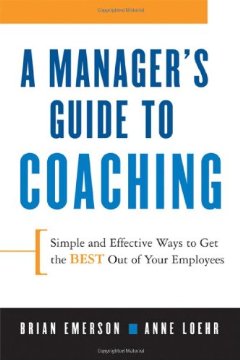 So you’ve decided that you’d like to take a coaching approach to managing your staff. You know when you should not coach, and when it can be an effective tool. But how to get started?
So you’ve decided that you’d like to take a coaching approach to managing your staff. You know when you should not coach, and when it can be an effective tool. But how to get started?
Before I get to that, if you’re a bit unclear on what coaching is and why managers would want to do it, you may want to check out this 2.5-minute video.
If you are ready to get started coaching your staff – or even if you don’t manage staff, but want to try a coaching approach with your colleagues, your clients, even your boss – I recommend my favorite book on coaching in the workplace, A Manager’s Guide to Coaching (affiliate link). Authors Brian Emerson and Anne Loehr spell out a six-step process for managers to coach their staff. The acronym for the process is W.I.N. B.I.G. – and although I’m not a fan of made-up acronyms that spell out real words, I admit it makes the approach easier to remember. I like their method because it’s straightforward, powerful, and takes into account the dynamic of boss and direct report.
As with any type of coaching, questions form the cornerstone of the conversation. The right questions can help the coachee (i.e., the person being coached) reach greater awareness and spur them to action. The book includes sample questions for each step of the process. Here is a summary:
1. Wonder About Root Cause
Rather than just jumping in to problem-solving mode, first get curious about what may be causing the problem. This helps define the problem more clearly.
Some questions you can ask in this phase:
- What do you think is really causing this situation?
- What’s holding you back from the goal?
- What is it about this situation that is keeping you up at night?
- In what ways are you not being the person you would like to be in this situation?
2. Investigate Wants – Visioning
Ask questions to help your coachee to get clear about what they really want in this situation, and who (e.g., what kind of person) they want to be as they do it.
Questions like these can help clarify:
- What does the desired end state look like?
- What would it take for you to feel really successful in this situation?
- How would you like people to describe you as you move forward in this situation?
3. Name Possible Solutions
Help your coachee to brainstorm potential ways to solve the problem. Encourage him/her to generate lots of options (plausible and seemingly implausible), without evaluating them at first. You can provide your own ideas, but be aware that they will carry more weight simply because they come from The Boss.
To jumpstart the brainstorming, you can ask questions like:
- What are some ways to make that [desired result] happen?
- What do you have to do to get where you want to go?
- How would Elon Musk solve the problem? Mother Theresa? Lady Gaga? [you get the idea]
Once your coachee has a healthy list of possible solutions, help him/her to analyze them and choose one. Keep the focus on the coachee, rather than you telling them which option you prefer. You may ask:
- Which of the possible solutions gets you closest to what you want?
- What possible solution is your favorite? What would that get you?
Just because your coachee prefers a certain solution does not mean you have to support it. Emerson and Loehr suggest that if they come up with something you cannot support – for business reasons, rather than your personal preference – you can say something like, “That’s a possible solution; here’s what I can get behind and here’s the part (and why) I can’t support. What else could get you where you want to go that takes those concerns into account?”
4. Build a Plan – Action
Help your staff member develop a practical, actionable, SMART plan to get them where they want to go. You could ask:
- What actions do you need to take to get you to your goal?
- When will you do that?
- What kind of support or resources do you need to ensure success, and how will you get them?
5. Insure Action – Accountability
Once your staff member has an action plan, you should build in accountability for taking the next steps. Otherwise, it’s likely that he/she may get too busy with day-to-day work and not implement the plan. You might ask:
- Will you let me know how it goes?
- How much time do you need before checking back in with me?
Discuss what you should do if they do not follow through on their commitments. You could ask, “How would you like me to follow up if I don’t hear back from you?” or “If you don’t follow through, how should I help you get back on track?” And then, be sure that you follow through. If you don’t, it sends a bad message and jeopardizes future coaching solutions.
6. Give Affirmation – Validation
This step can be used at any point during coaching, but is especially important at the end. Acknowledge your coachee’s hard work, and their commitment to professional and personal growth.
To develop an acknowledgment, ask yourself:
- What strengths do I see in this person right now?
- What do I see in this person that they might not see in themselves?
- Who is this person being right now, and how is that different from a month ago?
Whatever you say, be sincere. And after you deliver the acknowledgment, pause and let it sink in.
That’s the method, in a nutshell. Of course, it goes deeper than that, and if you’re interested, I recommend you read the entire book. But in the meantime, don’t let that stop you from taking a coaching approach. Even asking open-ended questions every once in a while, rather than giving your opinion right away, can help your staff members deepen their awareness and get inspired to take action.
Have you tried a coaching approach at work, either with people you manage, or colleagues, or – for those of you working in aid and development – your local partners and counterparts? How was the process for you? What were the results? I’d love to hear about it in the comments section below.

